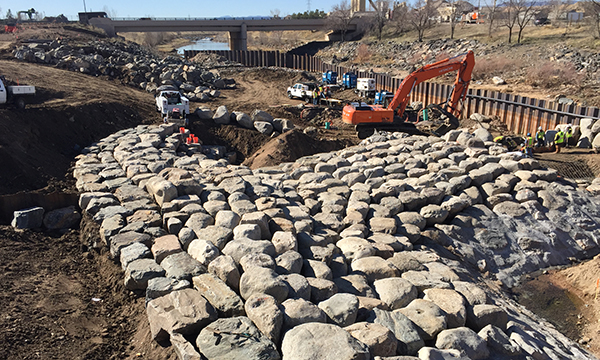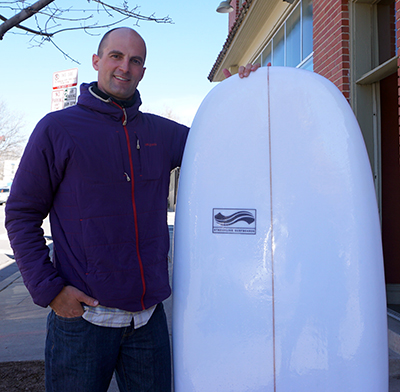A Denver engineer and his team are making some waves just south of Denver this year.
Ben Nielsen, a 34-year-old engineer who first dove into surfing while studying at Cal Poly, is building a new public park with waves for river surfers and kayakers along the South Platte River in Sheridan. It is publicly funded.
“If you build it, they will come,” said Nielsen, an engineer at Denver’s McLaughlin Whitewater Design Group, a subsidiary Merrick & Co. “I think these projects make a market for activities like stand-up paddle boarding, kayaking, really anything having to do with any kind of watercraft. I don’t think it’s a huge leap of faith to say that this park will help make a surfing market in Denver.”
Nielsen and his team plan to redevelop a half-mile stretch of the South Platte River, just north of Union Avenue, into a park with a jungle gym, trail system and underwater ramps for river surfing. The $14 million complex, called “River Run Park,” aims to add six surfable waves to the Platte once it’s complete in spring 2017.
The first phase, which is under construction and set to open this year, will feature ramps on the bottom of the riverbed that create waves by diverting the water’s flow. One of the ramps, called a “waveshaper,” has hydraulic pumps that can change its angle in order to alter the size of the waves.
The second phase, which will include a trailhead, fish habitat and four more wave features, will begin construction this year and is slated for completion in 2017.
The project is being funded through grants from Arapahoe County, the City of Englewood and the State of Colorado, Nielsen said. Get Outdoors Colorado (GoCO), a public institution that uses proceeds from lottery sales to fund outdoor projects, will vote on a resolution to fund the project next month.
Surfing rivers is different from riding the massive waves off the coast of Hawaii or California. For one, river surfers don’t actually move down the river while they ride. The waves from the underwater ramps push surfers in the opposite direction of the river’s flow, keeping them essentially in the same spot.
And river surfboards differ in design from their ocean counterparts. River boards generally use more fiberglass in their construction because they have to stand up to rocky riverbeds.
Nielsen previously helped design a similar park in Boise, Idaho, which wrapped up its first phase of construction in 2012.
He’s using that half-mile park as a template for River Run, he said, and cited its success as an indication of River Run Park’s potential.
“This is an amenity that makes markets,” he said. “Those markets can be renting equipment, building surfboards, anything related to the park.”
Also in metro Denver, stand-up paddle boarders and kayakers already utilize a stretch of the South Platte starting at Confluence Park during the summer months. Engineer Bill Taggart built kayaking rapids into that stretch of that river during the 1970s while he was working to lower the river’s flood plain around the area that is now Elitch Gardens.
At the time, it was one of the first manmade rapids in the world, according to Rick McLaughlin, a fellow water engineer and Nielsen’s mentor. McLaughlin renovated the nearly mile-long stretch of the Platte between Cherry Creek and I-25 during 1995 to make the manmade rapids a bit tamer.
“Back in the 1970s, one of the recreational issues was that (the river) would swamp and crush canoes,” McLaughlin said. “It was OK for kayaking but for anything else, it was too extreme.”
The renovations also included upgrades to the whitewater park to make it more accessible to landlocked Denverites.
“Around 80 percent of the people who use whitewater parks like Confluence are just there to watch and get their feet wet, so a lot of improvements were made to get more people right next to the water,” McLaughlin said.
A Denver engineer and his team are making some waves just south of Denver this year.
Ben Nielsen, a 34-year-old engineer who first dove into surfing while studying at Cal Poly, is building a new public park with waves for river surfers and kayakers along the South Platte River in Sheridan. It is publicly funded.
“If you build it, they will come,” said Nielsen, an engineer at Denver’s McLaughlin Whitewater Design Group, a subsidiary Merrick & Co. “I think these projects make a market for activities like stand-up paddle boarding, kayaking, really anything having to do with any kind of watercraft. I don’t think it’s a huge leap of faith to say that this park will help make a surfing market in Denver.”
Nielsen and his team plan to redevelop a half-mile stretch of the South Platte River, just north of Union Avenue, into a park with a jungle gym, trail system and underwater ramps for river surfing. The $14 million complex, called “River Run Park,” aims to add six surfable waves to the Platte once it’s complete in spring 2017.
The first phase, which is under construction and set to open this year, will feature ramps on the bottom of the riverbed that create waves by diverting the water’s flow. One of the ramps, called a “waveshaper,” has hydraulic pumps that can change its angle in order to alter the size of the waves.
The second phase, which will include a trailhead, fish habitat and four more wave features, will begin construction this year and is slated for completion in 2017.
The project is being funded through grants from Arapahoe County, the City of Englewood and the State of Colorado, Nielsen said. Get Outdoors Colorado (GoCO), a public institution that uses proceeds from lottery sales to fund outdoor projects, will vote on a resolution to fund the project next month.
Surfing rivers is different from riding the massive waves off the coast of Hawaii or California. For one, river surfers don’t actually move down the river while they ride. The waves from the underwater ramps push surfers in the opposite direction of the river’s flow, keeping them essentially in the same spot.
And river surfboards differ in design from their ocean counterparts. River boards generally use more fiberglass in their construction because they have to stand up to rocky riverbeds.
Nielsen previously helped design a similar park in Boise, Idaho, which wrapped up its first phase of construction in 2012.
He’s using that half-mile park as a template for River Run, he said, and cited its success as an indication of River Run Park’s potential.
“This is an amenity that makes markets,” he said. “Those markets can be renting equipment, building surfboards, anything related to the park.”
Also in metro Denver, stand-up paddle boarders and kayakers already utilize a stretch of the South Platte starting at Confluence Park during the summer months. Engineer Bill Taggart built kayaking rapids into that stretch of that river during the 1970s while he was working to lower the river’s flood plain around the area that is now Elitch Gardens.
At the time, it was one of the first manmade rapids in the world, according to Rick McLaughlin, a fellow water engineer and Nielsen’s mentor. McLaughlin renovated the nearly mile-long stretch of the Platte between Cherry Creek and I-25 during 1995 to make the manmade rapids a bit tamer.
“Back in the 1970s, one of the recreational issues was that (the river) would swamp and crush canoes,” McLaughlin said. “It was OK for kayaking but for anything else, it was too extreme.”
The renovations also included upgrades to the whitewater park to make it more accessible to landlocked Denverites.
“Around 80 percent of the people who use whitewater parks like Confluence are just there to watch and get their feet wet, so a lot of improvements were made to get more people right next to the water,” McLaughlin said.



Leave a Reply